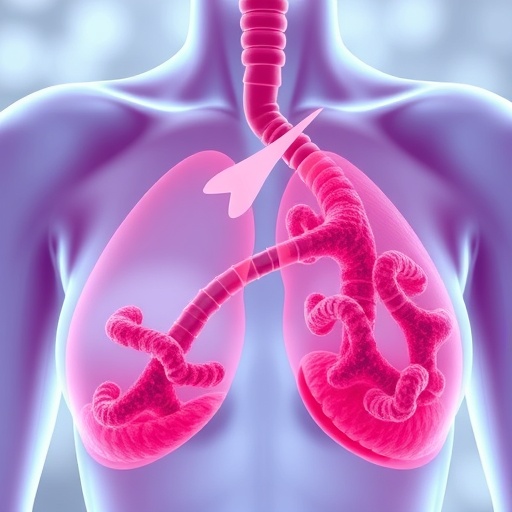A Groundbreaking Exploration into Nucleic Acid Metabolism’s Impact on Triple-Negative Breast Cancer Prognosis and Immune Dynamics
In the ever-evolving arena of cancer research, triple-negative breast cancer (TNBC) remains a formidable adversary due to its aggressive nature and limited treatment options. Traditionally elusive in terms of targeted therapies, TNBC’s malignancy is now increasingly understood through the lens of molecular biology and metabolic pathways. A recent comprehensive study spearheaded by Yang, Dong, Wu, and colleagues delves into a critical yet underexplored domain: the intricate involvement of nucleic acid metabolism-related genes (NAMRGs) in shaping TNBC’s pathological characteristics and immune milieu. This investigation, drawing upon transcriptomic analyses of 297 TNBC samples consolidated from three distinct datasets, unravels compelling mechanistic insights with far-reaching clinical implications.
Nucleic acid metabolism, a fundamental cellular process responsible for DNA and RNA synthesis, repair, and degradation, has long been recognized as a pillar supporting tumor proliferation by furnishing requisite biomolecules and energy. However, its specific role in TNBC biology remained inadequately characterized until now. The study harnesses advanced single-cell RNA sequencing alongside rigorous in vitro and in vivo experimentation to establish a nuanced portrait of how NAMRGs modulate tumor metastasis and the complex interactions within the tumor immune microenvironment (TME).
Central to the study is the identification of two discrete molecular subtypes of TNBC marked by distinctive NAMRG expression patterns. These molecular signatures intersect with existing stratification frameworks encompassing four genetic and four pathological subtypes, bridging molecular taxonomy with histopathological contexts. This multidimensional classification not only enriches our understanding of TNBC heterogeneity but also reveals a strong correlation between alterations in nucleic acid metabolism and homologous recombination repair defects (HRD), a key determinant of genomic instability and tumor evolution.
The ramifications of these findings extend to the TME, where altered nucleic acid metabolic activity is associated with shifts in immune cell infiltration profiles. Notably, the TME of tumors exhibiting specific NAMRG expression is characterized by immune exhaustion—particularly within CD8+ T cells—suggesting that nucleic acid metabolism may directly influence immune evasion mechanisms. This revelation positions NAMRGs not merely as passive metabolic players but as active contributors to immune modulation in TNBC, offering fresh therapeutic entry points.
Strikingly, the research introduces a robust prognostic tool, the NAM_model, constructed through the integration of four pivotal NAMRGs—DPYD, PDE6G, PDE8B, and TYMS—along with relevant clinical indicators. This prognostic nomogram reliably differentiates high- and low-risk patient cohorts, with the high-risk group exhibiting markedly poorer outcomes consistent with immune exhaustion phenotypes. Such precision prognostication could transform patient stratification, facilitating personalized treatment regimens tailored to metabolic and immunological tumor profiles.
Among the NAMRGs under scrutiny, PDE8B emerges as a particularly compelling oncogene with no prior association to TNBC metastasis. Experimental evidence from both cellular and animal models confirms PDE8B’s role in promoting tumor growth and facilitating epithelial-mesenchymal transition (EMT), a critical process underpinning metastatic dissemination. This novel link underscores the gene’s potential as both a biomarker and a therapeutic target, expanding the arsenal against TNBC’s metastatic propensity.
Beyond tumor behavior, the study reveals that NAMRG expression correlates significantly with differential sensitivities to chemotherapy and targeted therapeutic agents. This dimension holds immense translational value, indicating that nucleic acid metabolism not only impacts intrinsic tumor biology but may also dictate treatment responsiveness. Consequently, integrating NAMRG profiling into clinical workflows could optimize therapeutic selection and sequencing, elevating chances of treatment success.
Further dissecting the immune landscape, single-cell RNA sequencing offers granular insights into how nucleic acid metabolism intertwines with HRD to shape the phenotype of exhausted CD8+ T cells. The data suggest a feedback mechanism where defective DNA repair pathways exacerbate immune dysfunction, potentially perpetuating an immunosuppressive microenvironment. This interconnectedness highlights the complexity of tumor-immune interactions orchestrated at the metabolic level, advocating for combinatorial approaches leveraging metabolic inhibitors and immunotherapies to overcome resistance.
Importantly, this research embodies a holistic approach by interlinking metabolic pathways, DNA repair mechanisms, tumor heterogeneity, immune landscape, and clinical prognosis. Such integrative analysis transcends conventional single-angle studies, illuminating the multifaceted influence of nucleic acid metabolism in dictating TNBC’s pathobiology and patient outcomes. It invites a paradigm shift in how clinicians and researchers conceptualize cancer progression and therapeutic vulnerabilities.
The implications for immunotherapy are especially profound. Immune exhaustion within the TME has long been a barrier to effective immunomodulation in TNBC, a cancer subtype notoriously refractory to checkpoint inhibitors. Uncovering nucleic acid metabolism as a regulator of immune exhaustion paves the way for novel therapeutic combinations that might reinvigorate anti-tumor immunity and augment responses to immune checkpoint blockade.
This landmark study also challenges researchers to broaden their investigative scope to consider metabolic processes beyond traditional oncogenic signaling pathways. The metabolic state of tumors—particularly nucleic acid turnover—emerges not only as a hallmark of cellular proliferation but as an orchestrator of microenvironmental crosstalk and immune escape. This broadens the canvas for therapeutic interventions targeting metabolism-linked vulnerabilities.
In summarizing their work, Yang et al. emphasize that the integrated analysis of NAMRGs offers a vital bridge from molecular discoveries to clinical application. The ability to link metabolic gene expression profiles with clinical stages, pathological subtypes, immune phenotypes, and patient prognosis underscores the promising future of metabolism-informed oncology. Such breakthroughs herald a new era of precision medicine for TNBC, where insights into nucleic acid metabolism will inform prognosis, guide treatment, and perhaps fundamentally alter disease management.
As scientific inquiry accelerates, the validation of PDE8B and other nucleic acid metabolism-related genes as oncogenic drivers and predictive markers promises to spur drug development targeting these molecules. With further translational research, inhibitors modulating nucleic acid metabolic enzymes could complement existing therapeutic regimens, particularly in reversing immune exhaustion and curtailing metastasis.
Taken together, this comprehensive study unveils the hidden yet pivotal roles of nucleic acid metabolism in TNBC pathogenesis and immunology. It dispels previous uncertainties regarding the metabolic underpinnings of tumor aggressiveness and immune evasion, thereby charting a roadmap toward innovative, metabolism-oriented interventions. For patients grappling with TNBC, which often strikes with brutal intensity and limited treatment options, these findings kindle new hope for improved outcomes and durable remission.
This research not only enriches the current scientific canon but signals a clarion call to the broader cancer research community: to reexamine tumor metabolism as a multifaceted driver of cancer progression and immune landscape sculptor. The time is ripe for metabolism to move from the periphery to the forefront of cancer biology, where it belongs.
Subject of Research: Triple-negative breast cancer, nucleic acid metabolism, tumor microenvironment, immune exhaustion, prognostic modeling
Article Title: Effects of nucleic acid metabolism on prognosis and immune invasion of triple-negative breast cancer
Article References:
Yang, F., Dong, Y., Wu, S. et al. Effects of nucleic acid metabolism on prognosis and immune invasion of triple-negative breast cancer. Genes Immun (2025). https://doi.org/10.1038/s41435-025-00366-y
Image Credits: AI Generated
DOI: 06 November 2025
Tags: cancer metabolism and tumor growthimmune dynamics in TNBCmetabolic pathways in oncologymolecular biology of breast cancerNAMRGs and cancer prognosisnucleic acid metabolismsingle-cell RNA sequencing applicationstargeted therapies for TNBCTNBC treatment challengestranscriptomic analysis of breast cancertriple-negative breast cancer researchtumor microenvironment interactions





